27 JANUARY – 01 FEBRUARY 2025
By Jacob Roalef
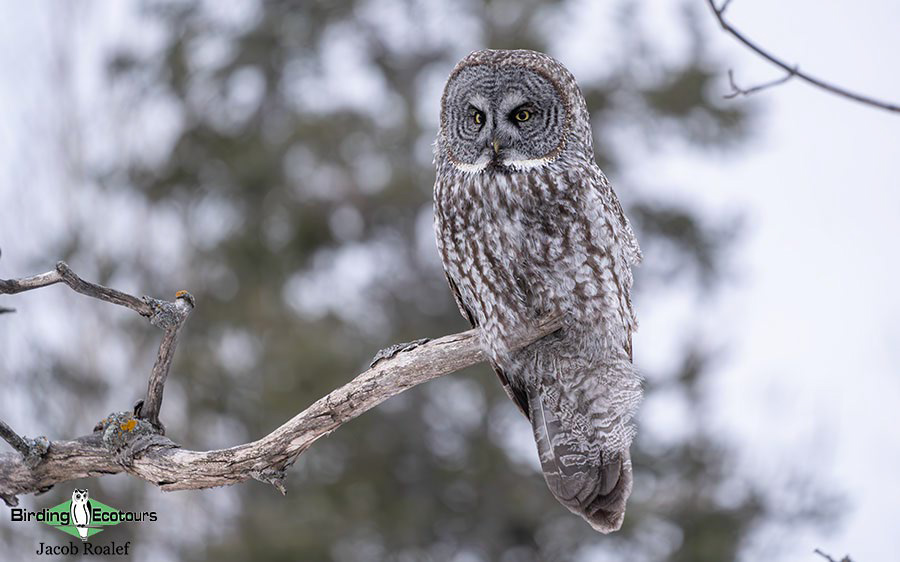
We were treated to amazing views of the iconic Great Grey Owl on this trip!
Overview
This tour was the first departure of back-to-back trips in Northern Minnesota, in which we partnered with Golden Gate Audubon and its members. This six-day trip began in Minneapolis, Minnesota on the 27th of January 2025, and concluded back there on the 1st of February. The tour visited many incredible birding sites, such as Sax-Zim Bog, the Grand Marais harbor, Palmer Lake, Nicols Road Marsh, Superior National Forest, Willowsippi Wildlife Management Area, and Lake Superior.
This was our first trip using a new route beginning in Minneapolis. The tour was able to achieve a new record high species list, including many new, first recorded species for our Minnesota tour. Bird highlights included Boreal, Great Grey, Long-eared, Barred and Snowy Owls, Northern Hawk Owl, Evening and Pine Grosbeaks, Redpoll, Canada Jay, Ruffed Grouse, Two-barred (White-winged) Crossbill, Lapland Longspur, Bohemian and Cedar Waxwings, Trumpeter Swan, American Tree Sparrow, and Great Grey (Northern) Shrike. A total of 62 bird species were seen, along with a few mammals, including Red Squirrel, White-tailed Deer, and Coyote. Full mammal and bird lists can be found at the end of the report.
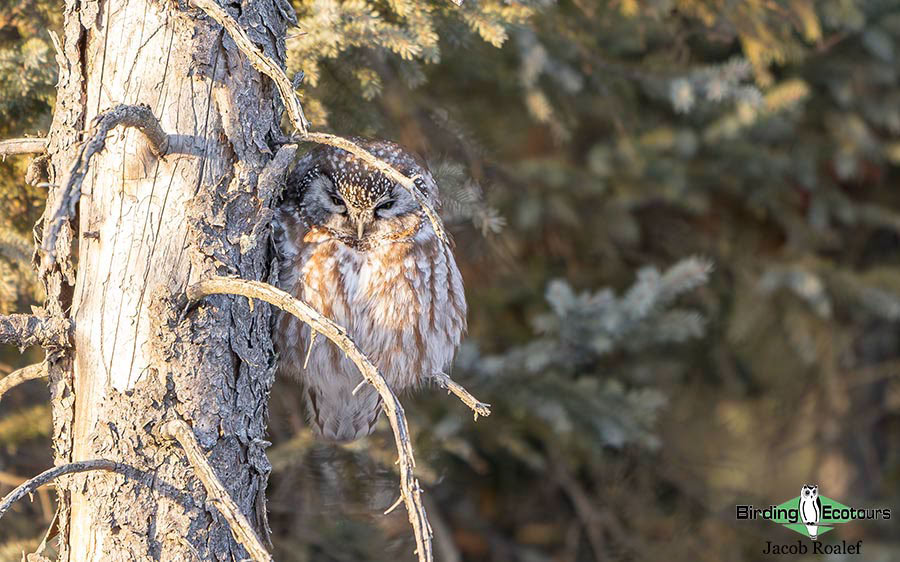
This Boreal Owl slept away, to the delight of many birders, and was a true star.
Detailed Report
Day 1, 27th January 2025. Arrival and Minneapolis birding
About half of the tour group had arrived by mid-morning, so we decided to pack in a little extra local birding nearby. We headed off for Black Dog Park. While we drove through the neighborhood, we spotted some of our first birds, House Finch and Eastern Bluebird, both great species to start the trip with. After a brief chat with a local, we made it to the park where a lovely group of American Tree Sparrows awaited us in the field nearby. From here we headed off to Nicols Road Marsh, which was hosting a real rarity for Minnesota. Upon arrival, about a dozen other birders were there, set up with scopes on the waterfowl. As we exited the van, a Belted Kingfisher sounded off and flew by, another great species to add. We walked our way down to the group of birders and they were all on the rare Mottled Duck mixed in with a few hundred Mallards. Unfortunately, it had its head tucked almost the entire time we were there, so looks were less than satisfying. However, we did manage to pull a nice Hooded Merganser out of the floating ducks, and we enjoyed our first looks at Trumpeter Swan. On our way out of the park, we pulled over to check out a very confiding Merlin perched next to the road. It was then time to fetch a few more members of our group and break for lunch. After lunch, with six out of seven of our group, more birding was on the schedule. We headed off for Palmer Lake but, unfortunately, the windy day really kept the afternoon birding slow. We noted some more common species, like Red-tailed Hawk and Bald Eagle before heading back to the MSP airport. As sunset approached, we spotted our first owl of the trip, a stunning Snowy Owl perched on a light pole! We watched as two others flew in and chased each other around, against a gorgeous sunset. What an incredible way to finish the day!
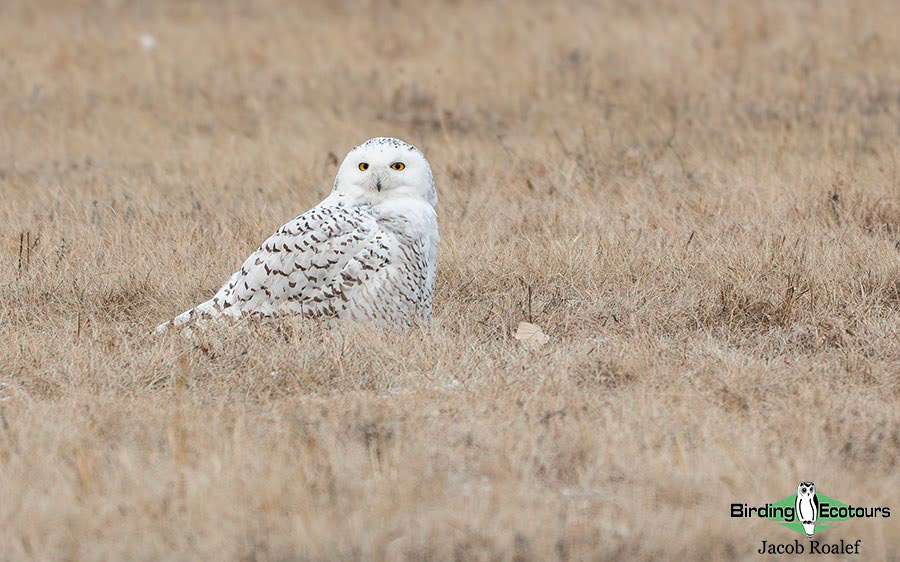
A Snowy Owl sighting was a great way to begin the trip.
Day 2, 28th January 2025. Palmer Lake transfer north, Sax-Zim Bog
Since we had only six out of seven participants yesterday evening, the plan for this morning was clear, head back to the airport first thing. After a false alarm with a Red-tailed Hawk, we spotted a Snowy Owl atop the nearby FedEx building! A fantastic start to the morning and now we all had our first owl of the trip. From here we circled back to the nearby Black Dog Park and Nicols Road Marsh and picked up some new species like Northern Cardinal, Green-winged Teal and Blue Jay as well some important repeat species like American Tree Sparrow and Trumpeter Swan. After these quick stops, we began our journey north, with a stop at Palmer Lake. This morning the weather was much nicer and, after about 20 minutes of searching, Gail spotted the Long-eared Owl we were hoping for! This species has amazing camouflage as it tucks itself in amongst the branches. It was time to leave Minneapolis behind us and make the 2.5-hour journey to Duluth. Along the way, we managed to spot a gorgeous Rough-legged Buzzard (Hawk) hunting the fields next to the highway. We also made a stop for lunch at a fascinating place called the Little Mermaid Café, which we all enjoyed very much, before making it into Duluth.
Upon arrival, we made a quick detour to the WLSSD, otherwise known as the local dump. Here we searched through the birds to spot both Glaucous and Iceland Gulls mixed in with the group of American Herring Gulls. We were lucky too, as a Bald Eagle swooped by shortly after and the gulls all scattered and never returned. After this we made it to the hotel, had a little time to get checked in and unpacked, before loading up again to head for an evening hour at Sax-Zim Bog. We had just the right amount of time and, as we pulled up, we were greeted by some incredible views of the majestic Great Grey Owl! We watched this bird up until sunset, before heading back to Duluth for dinner and toasted an amazing owl-day that started with Snowy Owl, ended with Great Grey Owl, and had a stellar Long-eared Owl sandwiched in between.
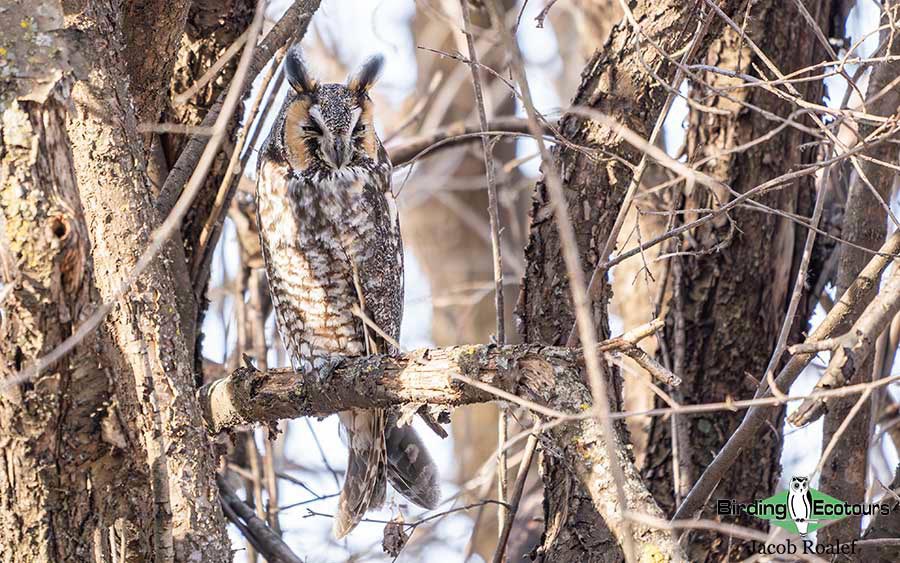
The camouflage of this Long-eared Owl was incredible to see.
Day 3, 29th January 2025. Sax-Zim Bog and Willowsippi WMA
After breakfast at the hotel, we set off before sunrise and headed toward Sax-Zim Bog. As we entered Arkola Road around first light, we were treated to incredibly close views of a Great Grey Owl perched on a street sign. Not a bad way to start the day. We spent some time with this owl, until it eventually flew into the woods. We continued along and made the left turn onto Owl Ave (a fitting road name) where we were treated with an adorable Barred Owl sleeping in the sun. Two owl species before 9am, this day was shaping up to be an incredible one. We spent the remainder of the morning back and forth between the Sax-Zim Welcome Center and the feeder station on Arkola Road. At the center we picked up our first finches of the trip, Redpoll, Purple Finch, and Pine Siskin. We then staked out the feeders at Arkola for about 30-40 minutes where we enjoyed Red-breasted Nuthatch, Hairy Woodpecker, Canada Jay, and a stunning male Pine Grosbeak. Once we were properly frozen, it was back to warm up inside the welcome center, of course we waved to the sleeping Barred Owl as we passed by it again. After we warmed up with coffee and window watching feeders, we made another pass by the Barred Owl and stopped in at the Arkola feeders again. This time our persistence paid off, as a Boreal Chickadee visited the feeders. This was important, as it was a very difficult year for this species. It was then time to warm up again and fill our bellies with some tasty food from Wilbert Café.
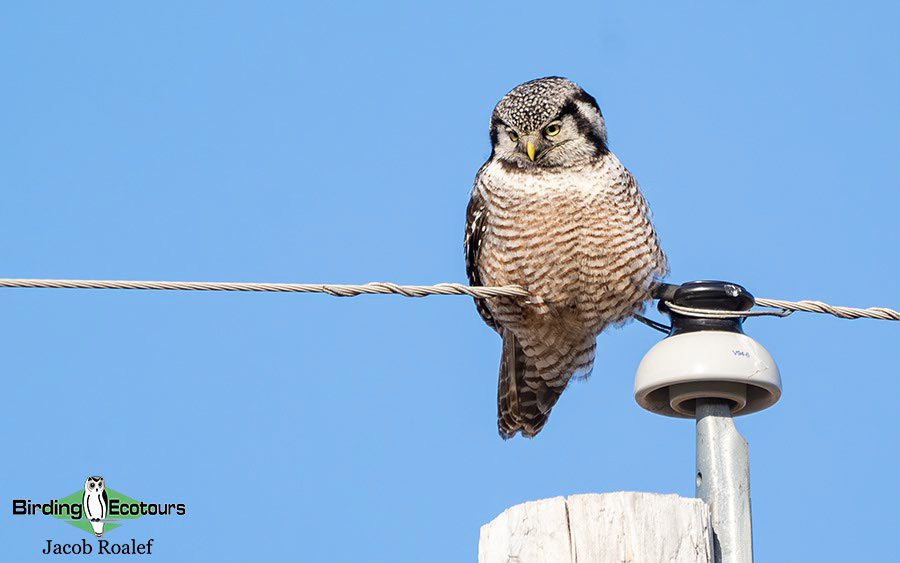
We all enjoyed stellar views of this Northern Hawk Owl on a wire
After our tasty lunch, we made the decision to keep this positive owl luck in our favor and drive out to Aitkin County, about an hour and a half journey. It turned out to be a great decision. As we pulled up, we were greeted by our main target, the striking Northern Hawk Owl! It was a very tough year for this species, so to enjoy one perched on poles and wire was a real treat. However, while we were there, we got word of a special bird that was spotted back on Arkola Road. So, after thorough enjoyment of the Northern Hawk Owl, it was back in the vehicle and back to the bog. Thankfully we arrived in time to find about 50 other birders and photographers all aimed at a cozy, sleeping Boreal Owl! What an incredible bird and our fourth species of owl for the day, somehow breaking yesterday’s mark of three. After about 30 minutes, the sun was getting low and the Boreal Owl woke up and flew back into the woods to begin its night of hunting and surviving the cold temperatures. As we walked back to the van, we managed to finally get onto a flock of Two-barred (White-winged) Crossbills as they foraged in the treetops. Typically, this species is just a fly-by, so to get some views was really nice. It was already time to make the journey back to Duluth and celebrate an incredible, owl-filled day!
Day 4, 30th January 2025. Sax-Zim Bog and northern forest birding
We headed north this morning, back toward Sax-Zim Bog. Along the way, as the sun began to rise, we got onto a Great Grey Owl along the roadside. It was truly spectacular to watch this amazing bird hunt for about 20-30 minutes, before it finally moved further away from the road. It’s tough to beat that start to the day. As we approached the bog, we entered through the Meadowlands, an area of pasture and farm fields. Here we managed to spot a Black-billed Magpie foraging amongst some cows. We continued on with a quick stop at the Welcome Center to visit the restrooms and say hello to the Pine Siskins and Redpolls visiting the feeders. We cruised the bog roads but things were a bit quiet this morning, until we reached the feeder station on McDavitt Road, known as the Zabin. Here we were treated to our top target of the morning, Evening Grosbeak. It was then off to Mary Lou’s house and her fantastic feeders. We spent some time with Purple Finch, Red-breasted Nuthatch, Downy and Hairy Woodpeckers, and American Goldfinch, a new species for the trip.
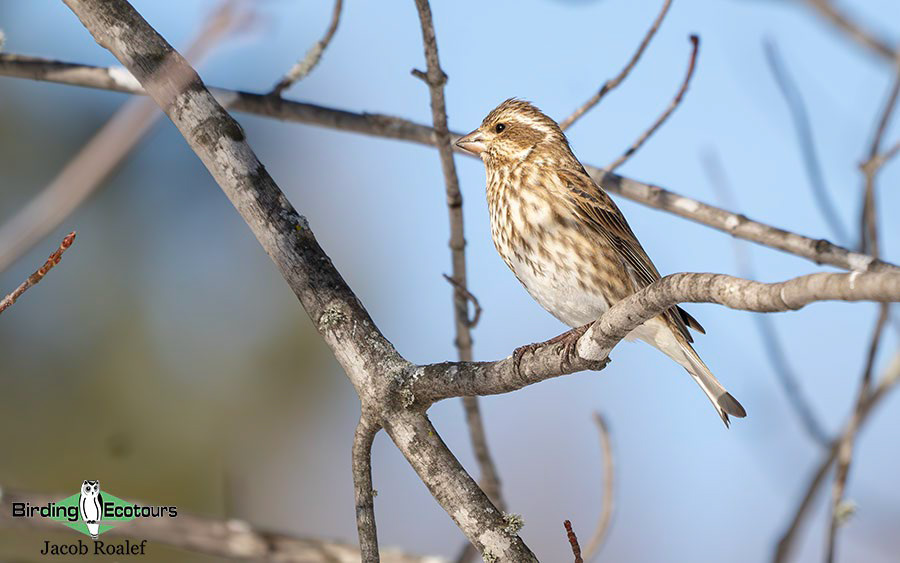
It was a fantastic year for Purple Finch around Sax-Zim Bog.
Just outside of Mary Lou’s, we spotted a Ruffed Grouse up in an Aspen tree. We managed to back up and, for the first time all trip, everyone managed to get a nice view of the bird before it flew off into the forest. It was getting close to lunch time, so we headed off to Hibbing, where we made a short detour to visit the childhood home of Bob Dylan. Lunch was full of fun, laughs, and Bob Dylan jokes. Once we were full and warmed up, we continued our journey north through the Iron Range of northern Minnesota, until we eventually reached Plum Creek Road. We unloaded and walked along this quiet and peaceful section of the forest, listening for any signs of woodpeckers. We saw a small flock of Two-barred (White-winged) Crossbills. Just as we were about to leave, the faintest taps could be heard and, sure enough, a lovely female Black-backed Woodpecker was working near the top of the tree. After we all enjoyed this great woodpecker, we loaded back up and headed for Johnson Road nearby. Here, we experienced something very similar to the quiet and peaceful forest of Plum Creek Road. The only real difference was that this time we managed to find a male Black-backed Woodpecker working hard. It was getting late in the day, and we had ventured far to the north, so it was time to begin our drive back to Duluth and listen to some Bob Dylan tunes to close out a fantastic day of birding.
Day 5, 31st January 2025. Lake Superior and Superior National Forest
Today, the plan was to bird along Lake Superior, cut into Superior National Forest for a bit, and really enjoy some amazing scenery along the way. We set off north along Highway 61 and stopped just outside of Duluth to take in a stunning sunrise on the lake. Along our journey we spotted two Great Grey Owls hunting the highway medians and margins. As we approached the town of Two Harbors, we cut inland towards Superior National Forest. A trio of Ruffed Grouse posed nicely for us along the roadside. Eventually we made it to Greenwood Lake, a small portion of forested land. It was beautiful but quiet and all we managed to turn up here was a Hairy Woodpecker. We continued our drive through the scenic forest until we made it back to Lake Superior. Another hour or so later we finally arrived in Grand Marais where we took a break for lunch.
While we looked over the menu and ordered our food, we spotted a small flock of birds out of the emergency exit window. Bohemian Waxwings! We ran out of the restaurant to try for some better views, but the birds had flown off already and would have to wait for now. After a delicious lunch, we headed off in search of those waxwings around town. First, we checked out near the harbor and picked up Common Goldeneye and Red-breasted Merganser. We continued our search at the Grand Marais RV park, where we discovered a nice flock of waxwings. Most of the birds were actually Cedar Waxwings but, with careful inspection and patience, we picked out several Bohemian Waxwings as well. It was a real treat to see both species side by side at times for excellent comparisons. We enjoyed these birds in the sun for a while before it was time to load up and begin our journey back to Duluth. Along the way, we took in the scenic views of Lake Superior, before eventually stopping in Two Harbors for a quick break. Down at Agate Bay Beach we spotted a fantastic Great Grey (Northern) Shrike, our first for the trip! We made it back to Duluth with just enough time to bird around the Canal Park and Park Point areas before sunset. We added American Black Duck to our trip list, always a great species to see up close. Just as the sun was setting and conditions were dark, Dan spotted a white blob way out on the ice. We hopped out to investigate and that blob started to fly. Snowy Owl! An incredible way to cap off a great day.
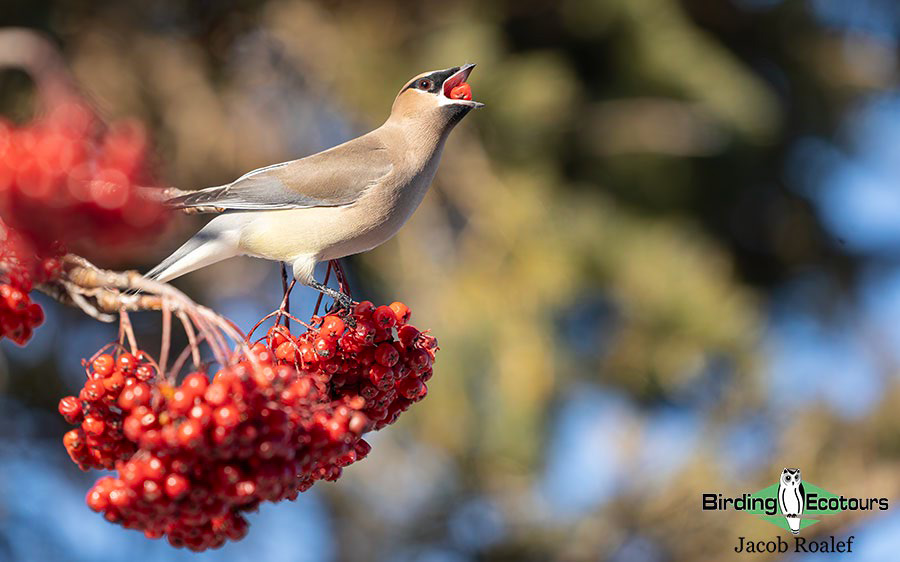
The sun was perfect on this Cedar Waxwing as it gobbled up berries.
Day 6, 1st February 2025. Highway 61 and back to Minneapolis
On our final morning, we had a little bit of time for some early birding. We packed our things and headed out for Highway 61. It was another gorgeous sunrise over Lake Superior, and it wasn’t too long before we were on a stunning Great Grey Owl perched right along the highway! We got to enjoy some quality time with this incredible species, and it even flew off and perched on the Highway 61 sign, certainly a nod to our Bob Dylan themed group. It was time to head back to Minneapolis with a stop for some coffee and delicious treats along the way. After our first round of airport drop-offs, the rest of the group still had time for some bonus birding. We ate lunch and headed out to some farm fields for more adventure.
Unfortunately, it was a very windy day, and some snow flurries didn’t help our visibility. We drove up and down some gravel roads as we searched the fields for new trip birds. Some brush along the edge of the field hosted American Tree Sparrow as well as Dark-eyed Junco, a new species. Finally, on our third pass, we stumbled into a small group of Lapland Longspurs and Horned Larks! A couple of great species to add to our Minnesota lists. As we made our final pass, we spotted a Peregrine Falcon sitting in the field, getting blasted by the wind, another new species. It was time to head back towards the airport. We picked up some new arrivals for the next tour and merged our groups for a short time. We had just enough time for a time scan of the airport area. It was a whole lot of nothing until, just before we hit the main road, Dan spotted something. Snowy Owl! This one was incredibly close and allowed for some excellent views. A great cap on our tour and a great start for those who had just arrived! It was back to the terminal where we said our goodbyes and farewells.

This adorable Barred Owl found a great place to sleep in the warm sun.
Bird List – Following IOC (14.2)
The following notation after species names is used to show conservation status following BirdLife International: CE = Critically Endangered, EN = Endangered, VU = Vulnerable, NT = Near Threatened.
| Common Name | Scientific Name |
| Ducks, Geese, and Waterfowl (Anatidae) | |
| Canada Goose | Branta canadensis |
| Trumpeter Swan | Cygnus buccinator |
| Gadwall | Mareca strepera |
| Mallard | Anas platyrhynchos |
| American Black Duck | Anas rubripes |
| Mottled Duck | |
| Green-winged Teal | Anas carolinensis |
| Common Goldeneye | Bucephala clangula |
| Hooded Merganser | Lophodytes cucullatus |
| Red-breasted Merganser | Mergus serrator |
| Pheasants, Grouse, and Allies (Phasianidae) | |
| Ruffed Grouse | Bonasa umbellus |
| Wild Turkey | Meleagris gallopavo |
| Pigeons and Doves (Columbidae) | |
| Rock Pigeon | Columba livia |
| Gulls, Terns, and Skimmers (Laridae) | |
| American Herring Gull | Larus smithsonianus |
| Iceland Gull | Larus glaucoides |
| Glaucous Gull | Larus hyperboreus |
| Hawks, Eagles, and Kites (Accipitridae) | |
| Bald Eagle | Haliaeetus leucocephalus |
| Red-tailed Hawk | Buteo jamaicensis |
| Rough-legged Buzzard | Buteo lagopus |
| Owls (Strigidae) | |
| Boreal Owl | Aegolius funereus |
| Snowy Owl – VU | Bubo scandiacus |
| Northern Hawk Owl | Surnia ulula |
| Long-eared Owl | Asio otus |
| Barred Owl | Strix varia |
| Great Gray Owl | Strix nebulosa |
| Kingfishers | |
| Belted Kingfisher | |
| Woodpeckers (Picidae) | |
| Red-bellied Woodpecker | Melanerpes carolinus |
| Black-backed Woodpecker | Picoides arcticus |
| Downy Woodpecker | Dryobates pubescens |
| Hairy Woodpecker | Dryobates villosus |
| Pileated Woodpecker | Dryocopus pileatus |
| Falcons and Caracaras (Falconidae) | |
| Merlin | Falco columbarius |
| Peregrine Falcon | Falco peregrinus |
| Shrikes (Laniidae) | |
| Great Grey Shrike | Lanius borealis |
| Crows, Jays, and Magpies (Corvidae) | |
| Canada Jay | Perisoreus canadensis |
| Blue Jay | Cyanocitta cristata |
| American Magpie | Pica hudsonia |
| American Crow | Corvus brachyrhynchos |
| Northern Raven | Corvus corax |
| Tits, Chickadees, and Titmice (Paridae) | |
| Black-capped Chickadee | Poecile atricapillus |
| Boreal Chickadee | Poecile hudsonicus |
| Larks (Alaudidae) | |
| Horned Lark | Eremophila alpestris |
| Nuthatches (Sittidae) | |
| Red-breasted Nuthatch | Sitta canadensis |
| Starlings (Sturnidae) | |
| European Starling | Sturnus vulgaris |
| Thrushes and Allies (Turdidae) | |
| Eastern Bluebird | |
| American Robin | Turdus migratorius |
| Waxwings (Bombycillidae) | |
| Bohemian Waxwing | Bombycilla garrulus |
| Cedar Waxwing | Bombycilla cedrorum |
| Old World Sparrows (Passeridae) | |
| House Sparrow | Passer domesticus |
| Finches, Euphonias, and Allies (Fringillidae) | |
| Evening Grosbeak – VU | Coccothraustes vespertinus |
| Pine Grosbeak | Pinicola enucleator |
| House Finch | Haemorhous mexicanus |
| Purple Finch | Haemorhous purpureus |
| Redpoll | Acanthis flammea |
| Two-barred Crossbill | Loxia leucoptera |
| Pine Siskin | Spinus pinus |
| American Goldfinch | Spinus tristis |
| Longspurs and Snow Buntings (Calcariidae) | |
| Lapland Longspur | |
| New World Sparrows (Passerellidae) | |
| American Tree Sparrow | Spizelloides arborea |
| Dark-eyed Junco | Junco hyemalis |
| White-throated Sparrow | Zonotrichia albicollis |
| Cardinals and Allies (Cardinalidae) | |
| Northern Cardinal | Cardinalis cardinalis |
| Total | 62 |
Mammal List
| Common Name | Scientific Name |
| Sciuridae (Squirrels and Allies) | |
| Eastern Gray Squirrel | Sciurus carolinensis |
| Red Squirrel | Tamiasciurus hudsonicus |
| Leporidae (Rabbits and Hares) | |
| Eastern Cottontail | Sylvilagus floridanus |
| Snowshoe Hare | Lepus americanus |
| Canidae (Dogs) | |
| Coyote | Canis latrans |
| Cervidae (Deer) | |
| White-tailed Deer | Odocoileus virginianus |
| Total | 6 |
This is a sample trip report. Please email us ([email protected]) for more trip reports from this destination.
